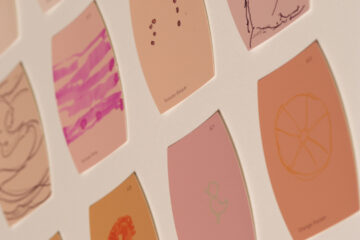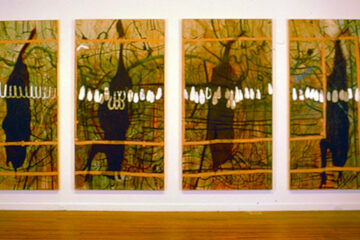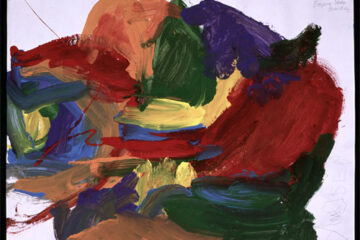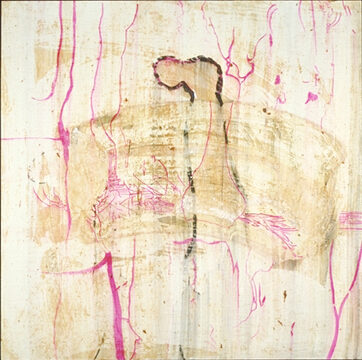
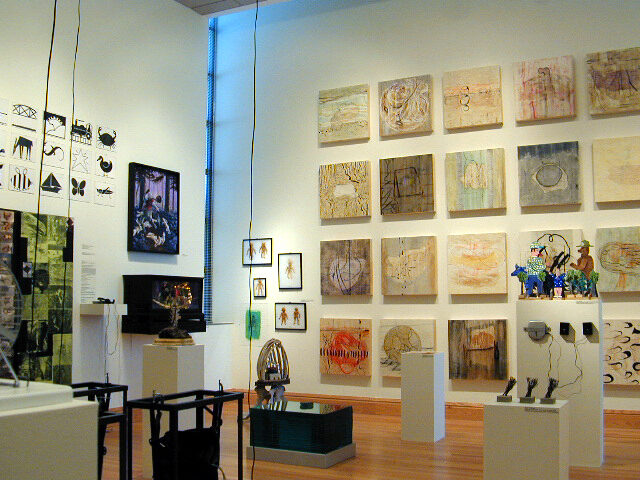



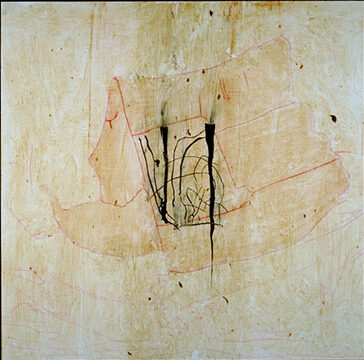
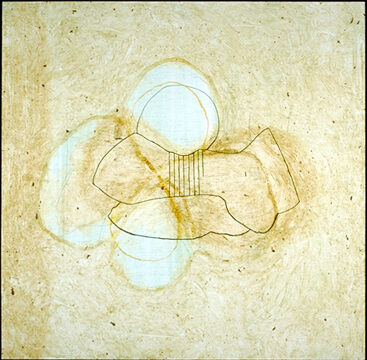

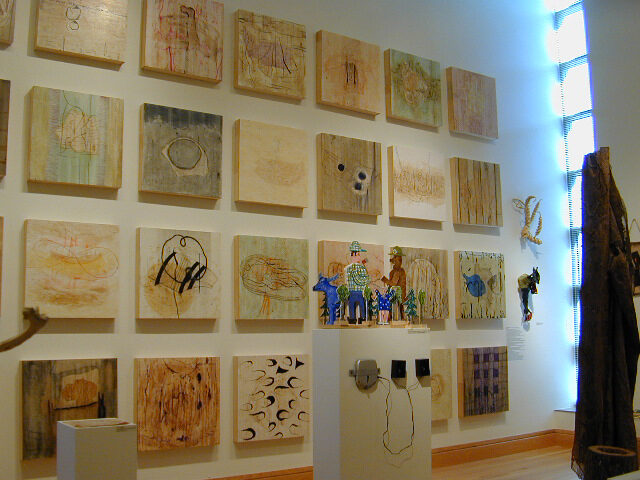
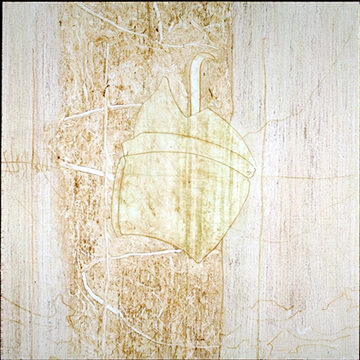

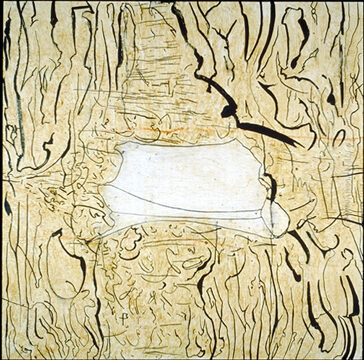
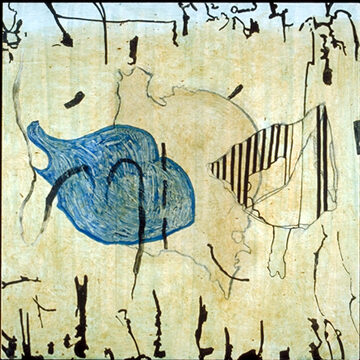
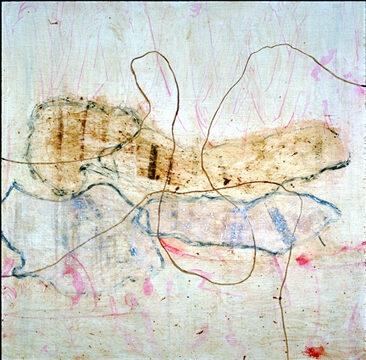
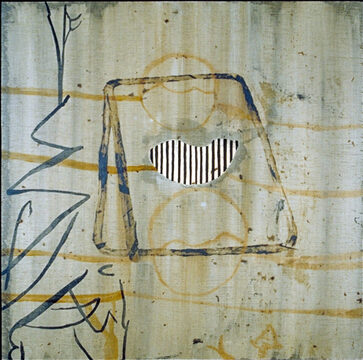
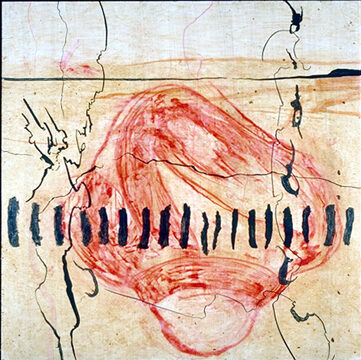

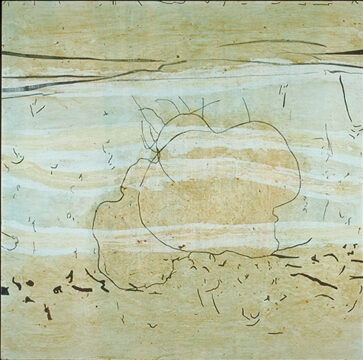

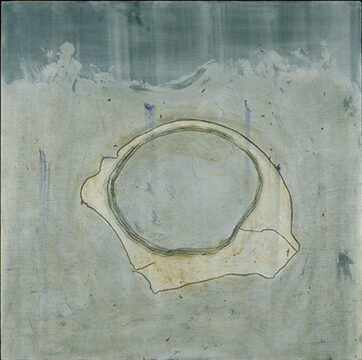


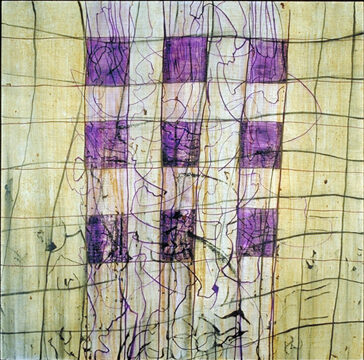
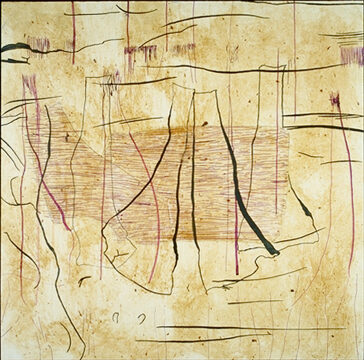
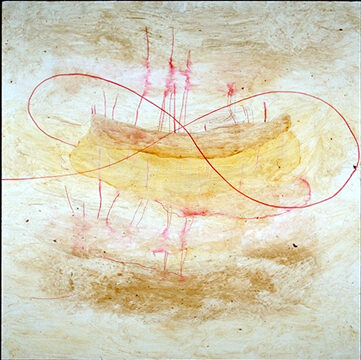

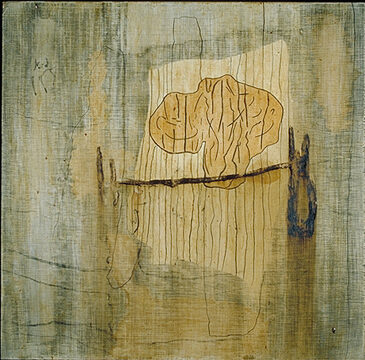
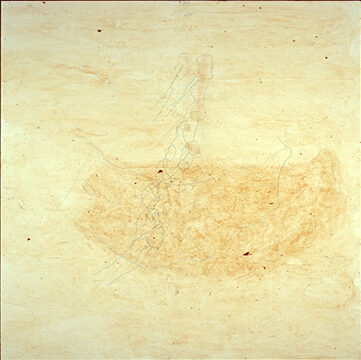

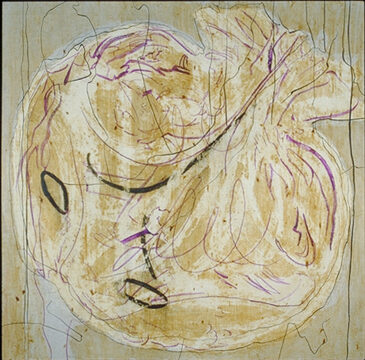
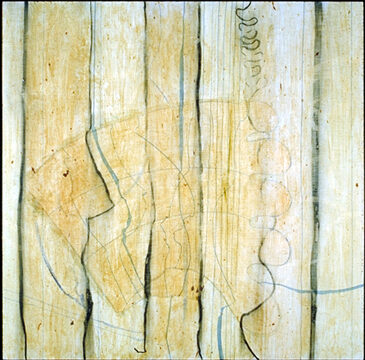
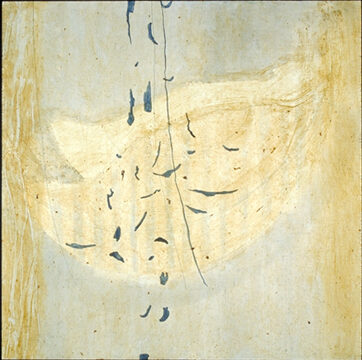
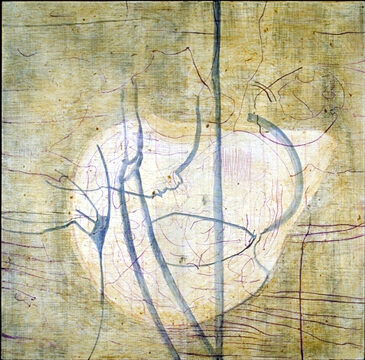

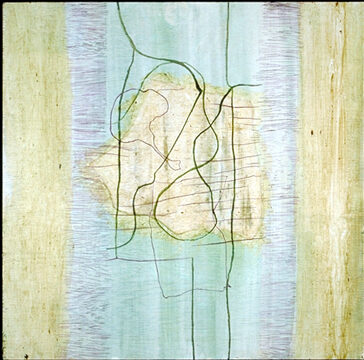
Nature Trail • Artist Statement
Quabbin Reservoir Series #2
Denise Tassin, Artist Statement
The Quabbin Reservoir series of 32, 2 x 2’ paintings resulted from subsequent investigation of objects found at a homestead site along the reservoir. Quabbin Reservoir, once the site of four towns and now Boston’s major water supplier, was built at the turn of the century. The objects found were remnants of past life at the reservoir site. They primarily consisted of broken glass and china, burnt glass, pottery chards, clock parts, bones and other miscellaneous items that you might expect to find in a pile of burnt trash dating from that period. The story of Quabbin and the discovery of the objects offered an interesting opportunity to study 32 select fragments and recreate what the stories surrounding the original objects might have been. The investigation was based on an intuitive response to each object.
Nature Trail
Villa Julie College
Curated by Gary Kachadourian
Work by Denise Tassin:
Quabbin Reservoir Series #2
November 1999 – February 2000
32 at 2 x 2’ each
1-8 First row.
9-16 Second row.
17-24 Third row.
25-32 Fourth row.
Materials: Beef liver, betadine, iodine, mercurochrome, methiolate, gentian violet, red clay, ink, ink wash, roofing cement, beet, food color, bodacious burgundy hair dye, coffee, spirulina, cochineal, fustic sawdust, logwood, achiote, paprika, dye, calamine lotion, turmeric, markers, oil paint stick and pencil.
Titles
1. The odor of roots of burning plastic smells no differently today.
2. The skull revealed the speed of the last rainfall.
3. Shimmers in the distance gave clues of the towns past activities.
4. The skin of seasons left a protective patina that defined the passing of time.
5. The charred remains of acquisitions defined status.
6. Torn pink lace and the fingerprints of soiled hands revealed their passion.
7. The smell of baking ham evoked the taste of green in his mouth.
8. Broken crocks stained with beets lined the trail near the reservoir.
9. The settlement became identifiable as a result of their shadows.
10. The sum of his life was reached by equating that he used the same belt to hold up the same pants.
11. The path of a turtle knows no certain speed.
12. At eleven o’clock everyday she stopped for a deep breath, cake and tea.
13. The sweat from her brow left a days labor upon her handkerchief.
14. Her fingers circled the patterns of the china plate set before her.
15. She was able to momentarily escape the mundaneness of her life by enlisting the aid of her imagination.
16. She used the low light of the lamp to conceal her blemishes while courting.
17. The darkness beneath his eyelids was comforting just before the amputation.
18. Liniment eased her aching joints.
19. Spit and spinner baits have worn his line thin.
20. They chose to let their wedding china remind them of their commitment as they sat solemnly eating.
21. Catfish prefer cooler temperatures for moving about the bottom of the lake.
22. The routine path of deer can be found out by mapping their feces.
23. Soles of a shoe weather the soul differently than a bare foot.
24. For weeks at the ladies luncheon on Wednesdays they discussed the bright blue desire of the unnamable.
25. Inside her thimble was the odor of days.
26. Not until time stopped did it begin.
27. He knew his path would take him no farther until it did.
28. The evidence of their presence was at first not clear.
29. Milks amethyst container continued to pour long after it was emptied.
30. The discovery occurred slowly, one object at a time.
31. Marked by heat, ashes and time the fragment was almost less than a clue.
32. Pinecones continue to fall randomly despite the perfect planting of the forest.
Nature Trail • Curator's Statement
Nature Trail
Gary Kachadourian, Curator
Nature Trail is a one-room exhibition of twenty-five artists where the goal is to have the work, as a group, create an environment similar in experience to walking a nature trail. The idea of the exhibition was to include multiple works which are rooted in the observation or experience of nature. The works in many cases are not literally about nature but evoke different elements one may choose to experience when walking. Some experiences would be to walk a trail as a specimen hunter/collector, to visit specific natural sites, to experience a complete natural environment, to see how different elements interrelate in nature or to use the linear aspect of the trail to understand natural mapping structures. The artwork in the exhibition can be categorized relative to these ideas.
Works which fit into the category of specimen hunter/collector are two fragments of larger works by Laure Drogoul. One is a series of cast rubber skins from the work “Evidence of Fairyland.” The other is a large opening panel from the installation “Nature Trail/Spook House” which has rows of photographs of animals killed on the road which become a review of living and dying in nature though the backdrop is asphalt. The thirty-two paintings by Sonia Denise Tassin are part of an ongoing body of work where each painting begins with an object found in a specific location. Through the painting process they become a kind of artist’s journey in which the original object becomes the center of a personal narrative. The urban sidewalk in Linda Day Clark’s photograph of a storefront is, in this context, a study of the layering of ground covering which is equivalent in both environments.
Stephen Lee and Beverly Ress also work with the collection and recording of specimens. Lee’s work is one of a group of woven straw sculptures based on botanical drawings from Captain Cook’s journeys. Ress’s are from a large series of drawings of natural specimens all drawn to scale on the same size paper with some objects filling the page and others just minor points on a large white sheet. Jann Rosen-Queralt’s sculpture, part of a larger installation, is a large ball covered in feathers and foam that originally represented one star in a constellation configuration placed in a reflecting pond. Alone it becomes a mysterious fragment with no clues to its larger context.
The image of the specific natural site exists with a number of works such as Allyn Massey’s piece made of rubber bladders, water and water pumps in a steel frame which burbles much like a natural spring. Pam Thompson’s work recreates a tree trunk using a cast rubber skin made from molds from tree bark. Maren Hassinger’s single line of wood scraps strung from floor to ceiling deals with the verticality of the forest and her wire rope and concrete sculptures evoke the living rooted form. In other works like Jack Livingston’s the site is represented as a large non-figurative painting which can be looked at as an accurate representation of the multiple layers of life in the shallows of a pond.
In Jan Razauskas’ piece famous natural sites are meticulously reproduced as drawings on white rubber erasers placed in a container. Jennifer Lynn Stewart Watson has built what is essentially a machine which strains flour which may be looked at as a metaphor for the ongoing processes of change in nature. Joyce J. Scott’s “Man Eating Watermelon” relates to the farm site ruins on many trails in its use of the rural African American stereotype of the watermelon.
The idea of the trail as a linear path is shown literally in Tom Miller’s flora and fauna pictograms which were commissioned to be used for a marker system on the Gywnns Falls Trail. Others like Western Cell Division’s hypodermic needle mapping project is like a Boy Scout trail project but instead of mapping erosion or fauna this project follows the trail of the urban hypodermic needle. Similarly The Tinklers have a chart for understanding the origins of objects one finds which is a kind of grade school guide map for finding icky things and their cut outs of Paul Bunyan and trees from a performance nod to the folklore of exploring new land and unrestrained consumption. Teri Reub’s piece is a sculpture based on a site-specific project she made for a trail in British Columbia where the viewer was conveyed stories of lose and mourning at selected points on the trail via an electronic device in their backpack.
Another group of works represent the trail as a way of experiencing a total picture of nature. Lyle Kissack’s painting is an observation on perceptual vision in a natural environment where a wooded landscape is partially obstructed by a toned paint overprint created with bubble wrap. Carl Clark frames the natural experience from the soldier’s point view in two photographs that span a twenty-year period. A single leafless tree in a blue fog in the first photograph is replaced by an American soldier’s helmet and foot surrounded by trees in the second. Darrell Wilcox enters nature as the idealistic hunter entering the environment and having it turn on him and make him fight for his life. Daniel Sullivan’s eight drawings are pseudo-scientific dissections of the mysteries of the forest with man facing a presumed alternate intelligence on the other side of nature.
The final category would be a study of interrelated objects. D. S. Bakker’s work is a diorama, in his words is a study of “beauty,” which is a sickly arrangement of artificial flowers and Christmas bows in an artificially lighted box. Fred Collins builds a diorama about information overload, which parallels the brain and computer microchips and has the Unabomber and his cabin in the woods as a major element. Tom Dixon’s instructional piece on trapping rabbits with a snare is part of an ongoing body of work where the rabbit has become a mythic creature overseeing every aspect of the artist’s life. Dan Van Allen builds a series of religious objects from old bones built in a very loose and natural way.
In the end this exhibition is an experiment in collecting a group of works and placing them closely together in a space to see how they read as a whole and individually. In most cases the works were not made specifically for the theme and the artists who were invited to build new works are not artists one would necessarily think of for this subject. In a sense the hope is simply to have the viewer walk a trail of artworks with the final read being as inconclusive and complex as it would be on a trail.
In closing, I would like to thank Villa Julie College and Gallery Director, Diane DiSalvo, for their support during the development of this exhibition. Their continued commitment to maintaining an exhibition space of this quality is of real importance to a continued and healthy art community in Baltimore.
D. S. Bakker
Crescendo. 1998
Wood, glass and ecstasy, 14” x 34” x 13”
Carl Clark
Army Life. 1980
Cibachrome print, 14” x 17”
Nature. 2000
Gelatin silver print, 20” x 24”
Linda Day Clark
Untitled. 2000
Color photograph, 20” x 16”
Fred Collins
Infotech! What’s Your Modem. 2000
Mixed media, 24” x 36” x 24”
Tom Dixon
The Path, the Gate and the Game. 2000
Mixed media, triptych, 20” x 48” total
Laure Drogoul
Highway Panel from Nature Trail/Spookhouse. 1989
Mixed media, variable dimensions
Homunculus Skins from Evidence of Fairyland.
Mixed media, variable dimensions
Maren Hassinger
When the Time Came, There Were No Leaves. 1988
Wire rope and concrete, three units, variable dimensions
Totem. 2000
Wood, 14’9” x 6” x 6”
Lyle Kissack
Half Cancelled Landscape. 1999
Acrylic and watercolor on paper, 16” x 20”
Stephen Lee
Banksia Intergrifolia. 2000
Woven straw, 18” x 12” x 12”
Jack Livingston
Fishing with Mr. Burroughs’ Cane. 1996
Mixed media, 96” x 108”
Courtesy of Gomez Gallery
Allyn Massey
Ripe. 1999
Rubber bags, lead, pumps and nylon, variable dimensions
Tom Miller
26 pictograms for a trail marker system on the Gwynns Falls Trail. 1998
Ink on paper, 11” x 8 ½” each
Commissioned by the Trust for Public Land
Made possible by a grant from the Maryland State Arts Council
Jan Razauskas
(need title.) 2000
Pencil on eraser and mixed media, variable dimensions
Beverly Ress
Baby Rabbit. 1996-2000
Colored pencil on paper, 30” x 22”
Placenta.
Colored pencil on paper, 30” x 22”
Rabbit.
Colored pencil on paper, 30” x 22”
Big Stick.
Colored pencil on paper, 30” x 22”
Moth.
Colored pencil on paper, 30” x 22”
Big Leaves.
Colored pencil on paper, 30” x 22”
Jann Rosen-Queralt
Alpha. 1998
Copper, sponge, feathers and Styrofoam, 40” diameter
Teri Rueb
Documentation of audio portion of “Trace: a memorial environmental sound installation.”
Yoho National Park, British Columbia. 1999
Cairn I. 2000
Glass, duratransparencies and aluminum lightbox, 26” x 20” x 25”
Joyce J. Scott
Man Eating Watermelon II. 1988
Beadwork
Collection of Tom Miller
Daniel Sullivan
Dreamland. 2000
Mixed media on Arches, 96” x 40”
Sonia Denise Tassin
Quabbin Reservoir Series #2. November 1999 – February 2000
The odor of roots of burning plastic smells no differently today.
The skull revealed the speed of the last rainfall.
Shimmers in the distance gave clues of the towns past activities.
The skin of seasons left a protective patina that defined the passing of time.
The charred remains of acquisitions defined status.
Torn pink lace and the fingerprints of soiled hands revealed their passion.
The smell of baking ham evoked the taste of green in his mouth.
Broken crocks stained with beets lined the trail near the reservoir.
The settlement became identifiable as a result of their shadows.
The sum of his life was reached by equating that he used the same belt to hold up the same pants.
The path of a turtle knows no certain speed.
At eleven o’clock everyday she stopped for a deep breath, cake and tea.
The sweat from her brow left a days labor upon her handkerchief.
Her fingers circled the patterns of the china plate set before her.
She was able to momentarily escape the mundaneness of her life by enlisting the aid of her imagination.
She used the low light of the lamp to conceal her blemishes while courting.
The darkness beneath his eyelids was comforting just before the amputation.
Liniment eased her aching joints.
Spit and spinner baits have worn his line thin.
They chose to let their wedding china remind them of their commitment as they sat solemnly eating.
Catfish prefer cooler temperatures for moving about the bottom of the lake.
The routine path of deer can be found out by mapping their feces.
Soles of a shoe weather the soul differently than a bare foot.
For weeks at the ladies luncheon on Wednesdays they discussed the bright blue desire of the unnamable.
Inside her thimble was the odor of days.
Not until time stopped did it begin.
He knew his path would take him no farther until it did.
The evidence of their presence was at first not clear.
Milks amethyst container continued to pour long after it was emptied.
The discovery occurred slowly, one object at a time.
Marked by heat, ashes and time the fragment was almost less than a clue.
Pinecones continue to fall randomly despite the perfect planting of the forest.
Beef liver, betadine, iodine, mercurochrome, methiolate, gentian violet, red clay, ink, ink wash, roofing cement, beet, food color, bodacious burgundy hair dye, coffee, spirulina, cochineal, fustic sawdust, logwood, achiote, paprika, dye, calamine lotion, turmeric, markers, oil paint stick and pencil, 32 pieces, 24” x 24” each
Pam Thompson
Tree. 2000
Cast rubber and wood, 96” x 24” diameter
The Tinklers
Lumpy/Mushy Chart. Circa 1980
Xerox, 8 ½’ x 11”
Props from the performance of Paul Bunyan. 1988
Acrylic on plywood, variable dimensions
Dan Van Allen
Bat and Ball in Bone Niche. 1995
Mixed media, 18” x 12” x 12”
Menorah. 1995
Mixed media, 12” x 18” x 8”
Monkey Crown. 1995
Mixed media, 6” x 12” diameter
Jennifer Lynn Stewart Watson
series of 9: spot. 2000
Steel and flour, variable dimensions
Western Cell Division
Hypo-stigma Project. 1989 to Present
Mixed media, variable dimensions
Darrell Wilcox
Nature Seeks Gun Control. 2000
Oil on canvas, 36” x 28”
